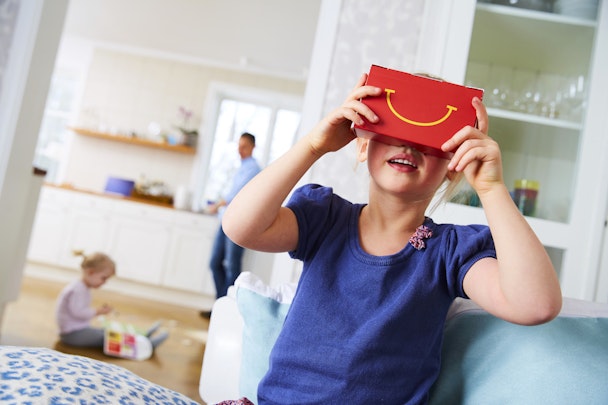Packaging hacks yield value, experiences and solutions
Pizza Hut customers in the UK can now potentially receive orders in what the brand calls “the world's first playable DJ pizza box.”

McDonald's Happy Goggles turn into VR readers.
That’s right: These limited edition pizza boxes double as turntables complete with cardboard controls when synced via Bluetooth to a laptop or smartphone thanks to a partnership with technology company Novalia.
And while it may take more than cardboard turntables for Pizza Hut to seriously challenge Dominos’ digital prowess, it is an innovative packaging hack.
Packaging tweaks have certainly been popular as of late.
Look no further than Budweiser, for example, which announced plans to replace its own name with “‘America’ on cans and bottles to kick off its ‘Most Patriotic Summer Ever’” in May, saying it wanted “to inspire drinkers to celebrate America and Budweiser's shared values of freedom and authenticity” through the 2016 election.
We’ve also seen Bud Light release team-specific cans for the NFL season and Coke not only launch cans with consumers’ names on them in its Share a Coke campaign, but also extend this effort to include song lyrics in Share a Coke and a Song. Meanwhile, Pepsi added its own Pepsimojis to bottles this year to celebrate summer.
Form meets function
But it’s not just messaging. There’s also some enhanced utility – and, naturally, user experience.
Take Orangina, for example, which released an Upside Down Can, which gently coaxes consumers to overcome their fear of shaking it as they turn it over to find the tab so that the pulp properly mixes.
And then there’s McDonald’s, which turned Happy Meal boxes into VR headsets for customers in Sweden and introduced specialized McBike packaging for its cycling customers to easily ride away with carryout orders in Denmark.
And, for her part, Lisa Sanders of Lisa Sanders Public Relations pointed to in-flight meal packaging from Icelandair, which includes words from the Icelandic language, as well as a pronunciation guide and a scannable code that unlocks additional traveler-friendly information like maps.
“Related to that, the cardboard box they use to deliver and serve the free in-flight meals for children not only serves to carry food, but also has cut-out characters that can be punched out of the cardboard container and played with,” Sanders added.
Doing good
And instead of simply throwing boxes away, online shoe and clothing retailer Zappos, widely known for its distinctive corporate culture, launched #IAmNotABox, in which it encourages customers to repurpose its packaging and give it a new life as, say, a cat mansion, a flower bouquet or a trash can drum. Zappos illustrates this concept in a rather heartwarming video in which a boy builds a home for a homeless man.
And then there’s CPG monolith Colgate-Palmolive, which Stewart Devlin, chief creative officer of marketing agency Red Peak Branding, said added educational materials like posters and lesson plans to boxes of goods shipped to Myanmar to help address a lack of supplies in schools.
“This example is brilliant because it does something for a higher purpose,” Devlin said, adding, "I believe brands need to be really careful that these types of ideas don't come off as a gimmick.”
Augmenting reality
And, for her part, Bethany Griffiths, content writer at SEO and digital marketing company Bowler Hat UK, cited the use of augmented reality to give packaging new life in a yet another way.
Indeed, VR/AR app firm Marxent Labs has worked with brands like Heineken, Tecate and King Arthur Flour to “[add] another layer of experience for consumers” to their respective packaging.
Heinz, too, teamed with AR app Blippar to turn ketchup bottles into digital recipe books.
“Augmented reality poses an exciting idea of where packaging, as well as the future of marketing, could be heading as the digital fuses with the physical and consumers [are] brought closer to brands,” Griffiths added.
Kit Kat, too, capitalized on its inherent similarity to the Japanese phrase “kitto Katsu,” which means, “will surely win,” and is reportedly considered good luck for students prior to their entrance exams, by selling a special Kit Kat in its Kit Mail Hologram promotion. These Kit Kats included a screen within the packaging, which created a 3D hologram on a mobile phone with a music video to cheer on students as they studied.
“What I liked about it was both the experience and the market it was launched in,” said Louis Marino, global executive creative director of experiential and retail at digital agency R/GA. “The Kit Kat brand is perfectly aligned with taking a break during life activities, especially things like homework.”

